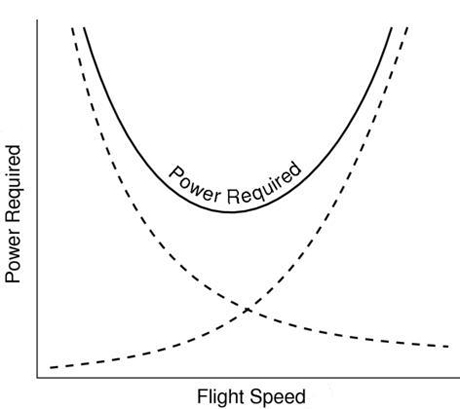Total drag is the sum of parasite and induced drag. It is least at a certain airspeed. At speeds greater than this minimum drag airspeed, parasite drag dominates, causing total drag to be greater. At speeds below, induced drag makes up the majority of total drag, causing total drag to be greater.
The amount of engine power required for the propeller to make enough thrust to counter total drag varies with airspeed, since drag varies with airspeed. The engine power required for different airspeeds is shown graphically in the power curve. It can be seen that the minimum power is required at the least drag airspeed. At any other speed, faster or slower, more power is required. At slow speeds near the stalling speed of the wing, the induced drag is so great, that the power required is very high.
The region of reverse command refers to the portion of the power curve in which the airspeed is less than the least drag airspeed. In this region, going slower actually requires more engine power, since induced drag is increasing as airspeed is lowered. If the airspeed is increased in the region of reverse command, less power is required to maintain a particular airspeed. Flying in the region of reverse command is commonly known as getting behind the power curve.
During takeoff, landing, and approach for landing the pilot may inadvertently cause the airplane to enter the region of reverse command. This is important to recognize, since a pilot is accustomed to adding power to go faster or climb.
If the airspeed is slow during an approach for landing, for example, the pilot may find the airspeed remaining low and the airplane sinking too low, even at full engine power. In this case, the pilot may be tempted to try and pull the nose up to slow the sink rate. It must be recognized that at this slow airspeed, there is so much induced drag that the engine cannot overcome it. The pilot must lower the nose, give up some altitude, and increase airspeed. This will reduce drag to the point where the engine can once again overcome it. After exiting the region of reverse command, the pilot can then easily fly the airplane back up to the proper descent angle for the runway and reestablish the proper approach speed.
The region of reverse command is usually encountered at low altitudes. This may not give the pilot adequate altitude to trade for airspeed.
